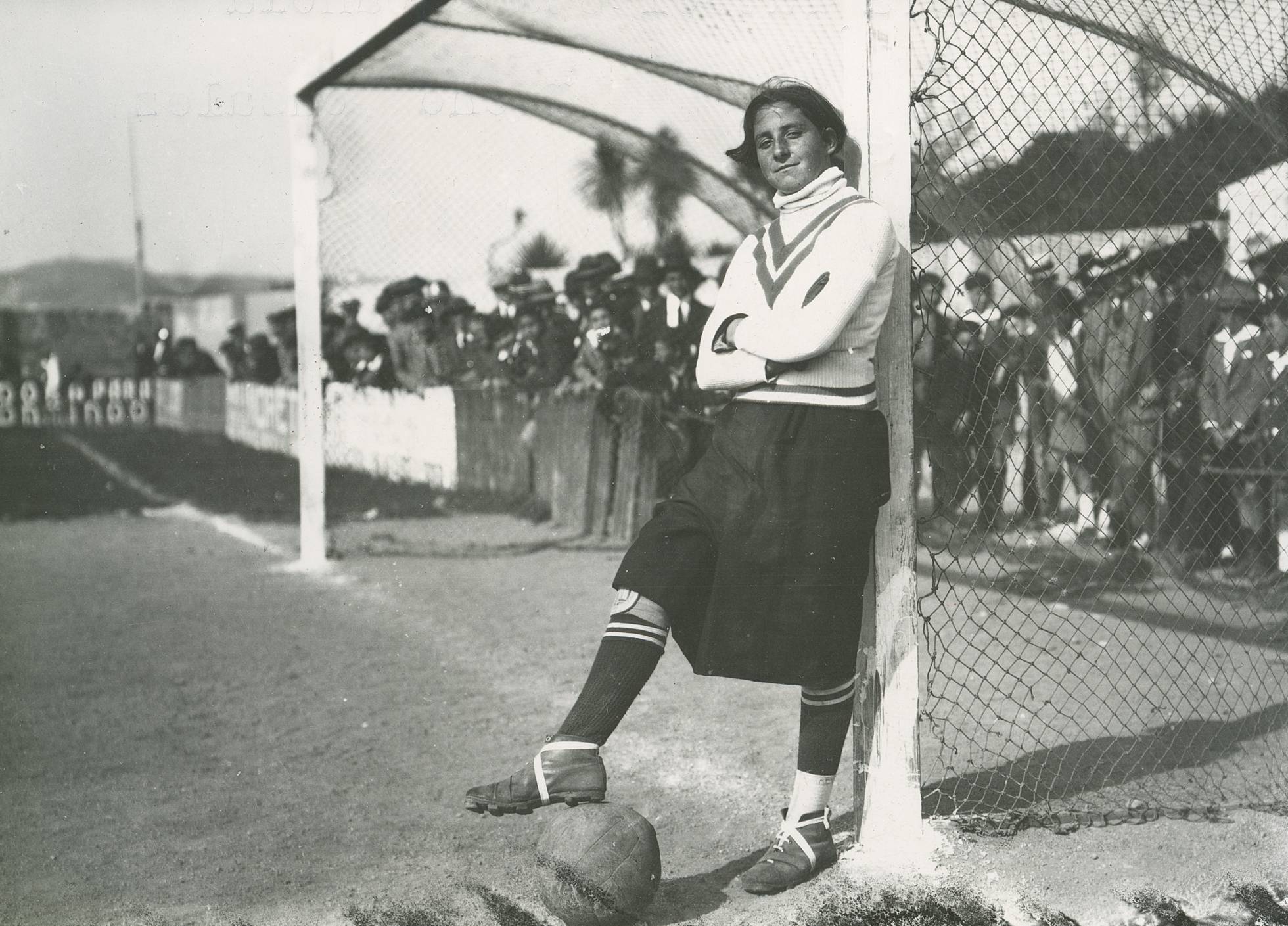A look at a pioneer of the women’s game in Spain

A goalkeeper leans on a goalpost, arms crossed, ball trapped under right foot, an assured, slightly amused gaze fixed upon the lens. Onlookers gather— men in suits and hats, boys in shorts and high socks. It is not immediately apparent whether their interest lies in the subject of the photograph or in the still relatively nascent technology that captures it. But a scan down the image dispels any doubts. Rather than the long shorts typical of goalkeepers of that era, the pictured custodian instead wears a skirt that settles just below her knees.
It is the sole remaining photograph of the pioneer of female participation in Spanish football. Before Conchi Sánchez, before Arantza del Puerto and Mar Prieto, before Verónica Boquete and Marta Torrejón, long before any of them, there was only one, one woman among men: Irene González.
Irene was born in La Coruña on 26th March 1909, seven years after football had been introduced to the Galician city by a student returned from England and just three years following the formation of Deportivo La Coruña, the city’s primary club. She grew up in the northern neighbourhood of Orillamar, where she was entranced by the street kickabouts and eventually started to join in despite protests from some of the local boys.
In 1924, as she turned 15, reports began to surface of a girl, known simply as Irene, who was making a name for herself participating in matches across the city, primarily at the A Estrada pitches but also at those of Monelos and Riazor, where Deportivo would later construct their stadium. She had begun as a striker but gradually dropped back to play as a goalkeeper, where her brave and confident performances quickly began to attract crowds.
The 1920s were a time of significant growth for football in Spain. The decade began with the national team securing a silver medal at the 1920 Olympics in Antwerp and ended with the formation of the national league. In this climate of growing interest in the sport, the uniqueness of a woman holding her own against men proved to be a popular draw. That, despite the fact that her own family were unhappy about her participation. There are accounts of her father dragging her, kicking and screaming, from the pitch.
At the end of 1924, frustrated at the disorganised state of some of the teams she had played for and certain that her popularity would ensure sufficient crowds and income, Irene decided to form her own club: Irene FC. The team played in friendlies and tournaments in the city and toured fiestas across the province. Takings were distributed amongst the squad, but the star attraction was undoubtedly Irene, whose appearance was a prerequisite to the team getting booked.
She was an almost mythical presence, this fearless and foul-mouthed goalkeeper, ranting and raving at her defenders and diving at the feet of forwards. Mystical, too. She placed a doll with the likeness of a footballer inside her goal to ward off the ball — an idea borrowed from Ricardo Zamora, perhaps Spain’s greatest ever goalkeeper — and one contemporary newspaper account claimed that “there is no one who can score against her.”
Irene was well-known and widely admired within the local sporting community and beyond, even if praise was often inevitably couched in sexist terms like “robust” and “tomboy.” (The original Spanish, marimacho, has stronger negative connotations than the English translation. See this from Brenda Elsey and Joshua Nadal.) Almost a century later, these comments are the bane of some modern-day players.
But her popularity was unable to insulate her from a tragically premature end. In the autumn of 1927, Irene contracted tuberculosis, the disease that would also claim the lives of three of her siblings, and was forced to stop playing. She pawned her clothes and belongings to cover the costs of her treatment, medicine and daily expenses. When fellow players learned of her situation, a charity match was organised. The money raised allowed her to repurchase her clothes, buy a mattress for her bed and catch up on overdue rent. But it eventually ran out, and her condition failed to improve. A letter was published in La Voz de Galicia entitled, “We must help Irene,” and collections were made at matches in La Coruña, Ferrol and Betanzos.
It was all in vain. On 9th April 1928, Irene passed away. She was barely 19 years old.
Her story was lost in the wider annals of Spanish football until journalist Óscar Losada revived it with his documentary short Irene, a porteira in 2008. For it, he spoke to the legendary, now deceased, Deportivo goalkeeper Rodrigo Vizoso, a contemporary of Irene who remembered her well. Vizoso revealed that she had often attended his matches and provided support from behind his goal.
But within her home city, her legacy was extended for many years after her death by a popular ditty sung by the little girls of La Coruña.
Mamá,
a footballer is what I want to be,
to play like Irene,
who plays so well.
Mamá,
when I am older,
I will make lots of money
playing football.
At the time that was an impossibility. Even now, with regular television broadcasts, sponsorship deals and sufficient spectator interest to draw crowds of 60,000 people, very few female players make lots of money. But at least young girls can now aspire towards football as a viable career. That they can is due in no small part to those like Irene González who fought to assert their presence in a sport that was rarely open to them doing so.
Nick Dorrington is a freelance football journalist for various outlets. Follow him on Twitter at @chewingthecoca.
